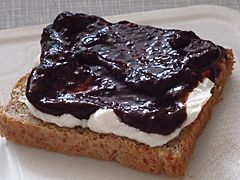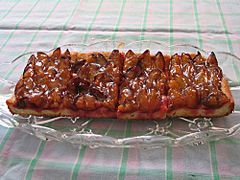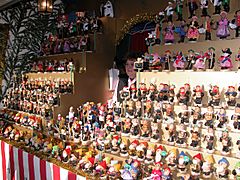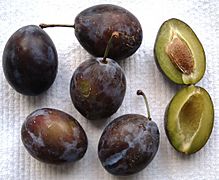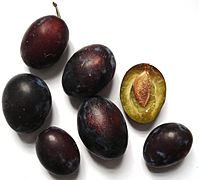Prune plum facts for kids
Quick facts for kids Prune plum |
|
|---|---|
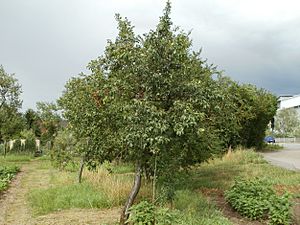 |
|
| Prune plum tree in fruit | |
| Scientific classification |
|
| Kingdom: | Plantae |
| Clade: | Tracheophytes |
| Clade: | Angiosperms |
| Clade: | Eudicots |
| Clade: | Rosids |
| Order: | Rosales |
| Family: | Rosaceae |
| Genus: | Prunus |
| Species: | |
| Subspecies: |
P. d. subsp. domestica
|
| Trinomial name | |
| Prunus domestica subsp. domestica |
|
| Synonyms | |
|
|
The prune plum (scientific name: Prunus domestica subsp. domestica) is a type of plum tree that grows delicious fruit. It is a special kind of plum that is very popular in Central Europe. Unlike some other plums, its fruit has a pit (seed) that easily comes away from the flesh. This makes it great for eating fresh or for baking!
Contents
What Are Prune Plums Called?
Prune plums are known by many different names around the world. In English, you might hear them called "blue plum," "damask plum," "sugar plum," or "German prune."
In German-speaking countries, they are often called "Zwetschge" (say: tsvetch-guh). This German word is where many other names come from, like "Kwetsen" in Dutch. These names, and even the word "damson," might have come from an old Latin word meaning "from Damascus," a city in Syria.
How Do Prune Plum Trees Look?
Prune plum trees often grow in special orchards called streuobstwiesen in Central Europe. These trees can grow quite tall, reaching about 6 to 10 meters (20 to 33 feet) high. Older trees have branches that spread out wide. Their bark is usually brownish.
The leaves are simple and grow about 4 to 10 centimeters (1.5 to 4 inches) long. They are oval-shaped with small, rounded teeth along the edges. In April and May, beautiful white, greenish-white, or yellowish-green blossoms appear on the tree. These flowers often bloom before or at the same time the leaves grow.
The fruit itself is a drupe, which means it has a hard pit inside. Prune plums are less round than other plums. Their ends are a bit more pointed, and the groove along the side is not as deep.
What Are Prune Plums Used For?
Prune plums are very useful! The wood from the tree is a reddish-brown color and is used to make beautiful cabinets and other fine wooden items.
The fruit ripens in August and September in the Northern Hemisphere. It's a favorite fruit to eat fresh when it's in season. Prune plums are also used to make prunes, which are dried plums.
Because prune plums hold their shape well when baked, they are often used in desserts. You might find them in tarts like quetschentaart or zwetschgenkuchen. They are also the main ingredient in powidl, a traditional jam from Austria and the Czech Republic. Another similar spiced jam from Silesia is called schmootsch.
People also use fermented prune plums to make strong fruit brandies, like zwetschgenwasser or quetsch. In Germany, especially at Christmas markets, you can find fun treats called zwetschgenmännla (little prune plum men) or zwetschgenweibla (little prune plum women). These are small dolls made with a walnut for a head, dried figs for a body, and dried prune plums for arms and legs!
Different Types of Prune Plums
There are many different kinds of prune plums grown around the world. Some popular varieties include 'Seneca', 'Stanley', 'Fellenberg', and 'Prunier d'Ente'.
In Central Europe alone, there are over a hundred different types! Some examples you might hear about are 'Cacaks Beste', 'Elena', 'Hauszwetschge', and 'Ortenauer'. Each variety might have slightly different flavors, sizes, or colors.



